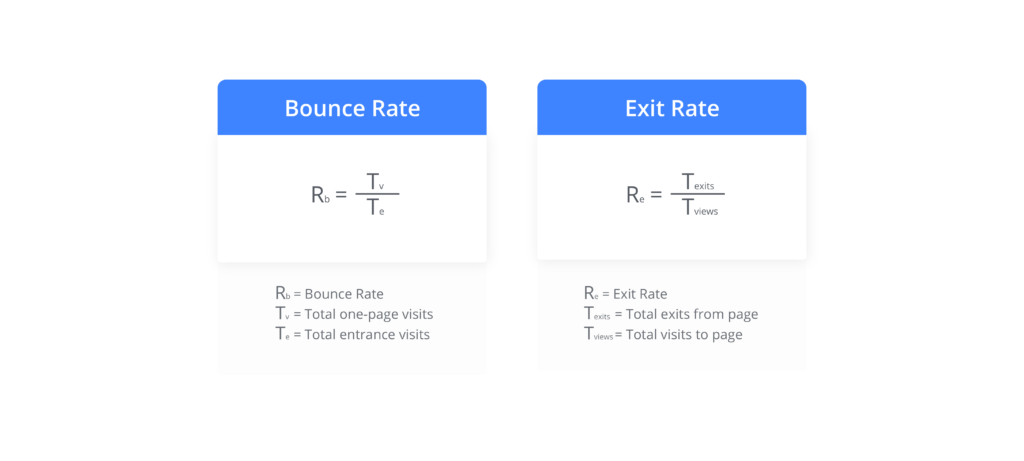Google Analytics is one of the best ways to determine how well your website is performing. It has plenty of useful metrics to help make this job easier, two of which are often misunderstood.
Bounce rate and exit rate. These metrics are not interchangeable, though many people confuse them.
Bounce Rate Vs Exit Rate | Understanding Analytics

If you really want to become a master of analytics, then you need to understand the slight differences in these two things. By the time you finish reading this article, you should have a comprehensive understanding of each of these metrics – along with ways in which you can reduce your exit rate!
What Is Bounce Rate?
As the name suggests, a bounce occurs when a customer lands on your landing page but doesn’t visit any other pages – they just bounce away.
If a user leaves before they can navigate to other pages, it counts as a bounce. Clicking the back button, typing in another URL, closing the tab, etc.
If you’re curious about what your bounce rate is, you can find it on the “Audience Overview” page.
What is a decent bounce rate then? Well, it depends on your industry.
Optimal Bounce Rates
- Portals – 10 – 30% bounce rate.
MySpace, Facebook, etc. - Basic Landing Pages – 70 – 90% bounce rate.
These include pages with little content and a single call to action.
- Service Sites – 10 – 30% bounce rare.
Such as FAQ sites and self-service sites.
- Lead Generation – 30 – 50% bounce rate.
Services for sale.
- Content Websites – 40 – 60% bounce rate.
Websites that have high search visibility fit into this category.
- Retail Sites – 20 – 40% bounce rate.
Such as Amazon, Alibaba and eBay.
In a few rare circumstances you might want a higher bounce rate, but overall you should aim to keep it low.
80%+ is terrible
70 – 80% is poor
50 – 70% is mediocre
30 – 50% is brilliant
20% or below is probably an error
Keep this in mind when examining your bounce rate.
How Are Exit Rate And Bounce Rate Different?
Simply put, the page with the highest exit rate is the page where most of your visitors left from.
By knowing your exit rate percentage, you can gain an understanding of how users navigate your site.
A high exit rate isn’t always a bad thing though! For instance, if you find that many customers are exiting on your “contact us” page, that’s probably perfectly normal. The customer may have simply been searching for your email address. Once they found it, they had no more reason to stay on the site.
However, if you think you have a particularly juicy piece of content that people are navigating away from, then It’s time to optimize.
We don’t want you to think of having a high exit rate as an inherently bad thing though. Customers can’t be expected to stay on your website all day, and naturally must leave at some point.
This is one of the main reasons why understanding the differences between exit rate and bounce rate is so vital.
A lot of your bounce rate might be people clicking onto your pages, believing them to be something else. Additionally, if a customer searches for “What flavor of Chupa Chups are there?” then a customer is going to bounce the moment their query has been answered.
Now, if a customer spent time navigating your website before landing on that page and exiting, then that could be a different matter entirely. Perhaps they got bored, the content might have not been clear enough, or maybe they simply had to leave – this is why you need your exit rate ratio.
Let’s say a page only has an exit rate of a few percent. You probably shouldn’t waste too much time trying to figure out what’s wrong with it.
If you do , you’ll find yourself trying to perfectly optimize every page, and that will result in you being spread too thin – which will then translate into lower quality pages overall.
How can understanding this help me though? Read on to find out!
Click Rate, Bounce Rate, and their relationship with SEO.
Now that you understand bounce rate vs exit rate, you can put this valuable information to use – scanning web pages and marking the ones that have a poor bounce rate is a good place to start! You can then better optimise them to draw people in.
Likewise, by taking a look at which pages have a poor exit rate, you can add some more calls to action.
Factors That Negatively Affect Your Bounce and Exit Rates
- Poor page design – if your only font is comic sans and the main color of your page is radioactive green, it’s time to work on it.
- Load times – People are impatient. If users have to wait more than a couple of seconds to get onto your page, you’ll lose them.
- Unclear Message Of The Page – Users don’t navigate to sites so that they can partake in a brain teaser. You need to establish the purpose and message of your post straight away.
- Annoying Ads – We’re not saying you need to avoid ads altogether, but there are a few types of ads you should stay away from. Pop-ups and autoplay videos are our least favorite – especially when the video ad begins playing halfway through the page, so you have to scroll down to find it.
These are excellent ways to start fixing your bounce and exit rates. Of course, you might want to consider checking your content too.
Grammar and spelling errors can sometimes come across as a lack of professionalism. Of course, it’s not enough to know how to use bounce rate and exit rate to optimize your pages.
You can make a good start of course, but if you really want to optimize your website for SEO, things get a little trickier. You likely don’t have the time to invest in improving everything, but there’s no need to worry.







Leave a Comment
You must be logged in to post a comment.